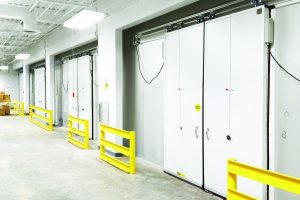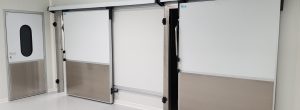Choosing the Right Door for Your Cold Room: A Comprehensive Guide
Introduction
When it comes to maintaining the temperature and integrity of a cold room, selecting the appropriate door is of paramount importance. Cold rooms are used in various industries such as food storage, pharmaceuticals, and scientific research, where precise temperature control is essential. In this guide, we’ll explore the factors to consider when choosing a door for a cold room and delve into different types of doors that are suitable for such environments.
Factors to Consider
1. Temperature Control
Maintaining a consistent temperature is the primary objective of a cold room. The chosen door should be capable of minimizing heat transfer between the cold room and its surroundings. This ensures that the contents of the cold room are kept at the desired temperature, preserving their quality and safety.

2. Insulation Properties
Insulation is a key consideration for cold room doors. High-quality insulation materials help prevent thermal bridging and minimize heat exchange. Insulated doors with low U-values are effective at keeping the cold air in and the warm air out, reducing energy consumption and operational costs.
3. Door Size and Traffic
The size of the cold room door and the frequency of use play a significant role in selecting the right door type. For high-traffic areas, doors that open and close quickly can help maintain temperature levels more effectively. Additionally, choosing the appropriate door size ensures efficient movement of goods and personnel in and out of the cold room.
4. Durability and Maintenance
Cold room doors must withstand frequent use, temperature fluctuations, and potential exposure to moisture. Opt for doors made from durable materials that are resistant to corrosion, warping, and other forms of wear and tear. Ease of maintenance is also crucial to ensure the longevity of the door’s performance.
5. Regulatory Compliance
Depending on the industry and location, there might be specific regulations and standards governing cold room construction and equipment. Ensure that the selected door meets relevant safety and hygiene standards to avoid compliance issues.
Types of Cold Room Doors
1. Sliding Doors
Sliding cold room doors are a popular choice due to their space-saving design and efficient sealing capabilities. These doors slide horizontally, minimizing the air exchange between the cold room and the outside environment. They are suitable for areas with limited space and moderate traffic.
2. Swinging Doors
Swinging doors are hinged and open either inward or outward. They are easy to operate and are commonly used in areas with moderate to low traffic. Swinging doors provide a tight seal when closed, contributing to effective temperature control.
3. Roll-Up Doors
Roll-up cold room doors are constructed with horizontal slats that roll up into a compact housing. These doors are ideal for spaces with high traffic flow, as they can open and close quickly. Their design reduces the time during which the cold room is exposed to warmer temperatures, helping maintain the desired climate more efficiently.

4. High-Speed Doors
High-speed cold room doors are engineered for rapid opening and closing. They are equipped with advanced technology such as motion sensors and fast-acting motors. These doors are suitable for areas with constant traffic and where minimizing temperature fluctuations is critical.
Selecting the Right Door
Choosing the most suitable cold room door depends on a combination of factors, including the specific requirements of your facility and the nature of the stored items. Here’s a step-by-step guide to help you make an informed decision:
Step 1: Assess Your Needs
Determine the size of the cold room, expected traffic volume, temperature range, and any regulatory compliance requirements. These factors will guide your choice of door type and features.
Step 2: Prioritize Insulation
Opt for doors with excellent insulation properties. Look for doors with insulated panels, weather seals, and features that minimize thermal bridging. A well-insulated door significantly contributes to energy efficiency.
Step 3: Consider Traffic Flow
Evaluate the frequency of door usage. High-traffic areas benefit from doors that can open and close quickly to minimize temperature fluctuations. Choose a door type that suits your traffic patterns.
Step 4: Choose Material Wisely
Select materials that are durable and corrosion-resistant. Stainless steel, fiberglass, and insulated metal panels are common materials used for cold room doors. The chosen material should withstand the cold environment and potential exposure to moisture.
Step 5: Safety and Compliance
Ensure the selected door meets industry-specific safety and hygiene standards. This step is crucial, especially for applications involving food storage, pharmaceuticals, and medical supplies. https://commgen.com.au/wp-content/uploads/2019/10/3.fire_performance.pdf
Conclusion
Selecting the right door for a cold room is a decision that requires careful consideration of various factors. From insulation properties to traffic flow and regulatory compliance, each aspect plays a crucial role in maintaining the desired temperature and quality of the stored items. By assessing your facility’s needs and understanding the different door types available, you can make an informed choice that contributes to energy efficiency, safety, and overall operational effectiveness in your cold room environment.
